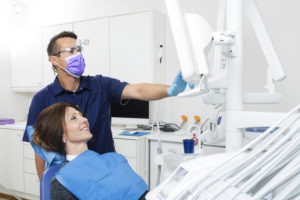The National Institute of Dental Craniofacial Research estimates that more than 50 percent of people with oral cancer in the United States survive 5+ years. In fact, the earlier it’s caught, the higher your chances are of successfully treating oral cancer. Your dentist will look for early signs and symptoms during your regular checkup, but you should also know what to look for in case any symptoms emerge between visits. To demystify the process, we rounded up common symptoms and details of what you can expect when you undergo oral cancer screening.
Symptoms of Oral Cancer
Oral cancer can affect any part of your mouth, including your throat, lips and tongue. It can also occur in your pharynx, larynx, sinuses and salivary glands. Early detection is often one of the most important factors in successfully treating and overcoming the disease. Contact your dentist if you experience any of the following symptoms for two weeks or longer:
- Sores, swollen areas, lumps or thick patches
- The sensation of having a lump in your throat
- White or red lesions on your lips or in your mouth
- Numbness, tenderness or pain
- Trouble chewing, swallowing or speaking
- Difficulty moving your tongue or jaw
- Swollen areas that make it uncomfortable to wear dentures
- Pain in one ear without loss of hearing
- Hoarseness or a lingering sore throat
- Loose teeth
Risk Factors
The causes of oral cancer are unknown, but several lifestyle factors can put you at a higher risk for the disease. The Oral Cancer Foundation reports that 90 percent of oral cancer sufferers consume or have consumed tobacco products. Likewise, heavy alcohol use, poor eating habits and sun exposure can increase the chance of developing oral cancer.
Types of Oral Cancer Screenings
These specialized screenings examine your oral cavity and its related tissues to identify any possible problems and treat them as early as possible. Dentists may also use these screenings to assure patients that their mouths are healthy. Types of oral cancer screenings include:
Visual Exams: Your dentist will look at your face, neck and lips and check inside your nostrils and oral cavity to identify any early warning signs.
Physical Exam: Your dentist may also palpate or touch your head and cheeks, under your chin, around your jaw and in your mouth to feel for any masses or nodules.
Additional Tests: In some cases, your dentist might also use a special test to go beyond visual or physical exams. One example involves using a special blue dye to rinse your mouth; abnormal cells may be revealed when they absorb the dye.
If you notice any unusual signs or symptoms, don’t hesitate to call Klement Family Dental to make an appointment with one of our caring professionals. We’ve been serving the Tampa area for more than 35 years, and we offer a full menu of preventive care, cosmetic dentistry and more.


